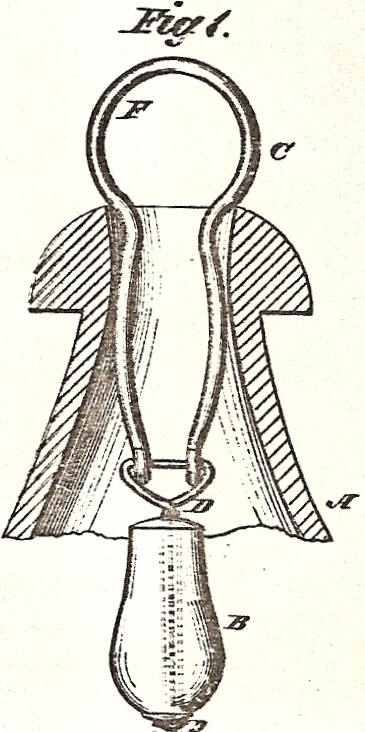Joel B. Miller Bottle Stopper
U. S.
Patent Number: 156,302
Patented: October 27, 1874


Joel B.
Miller’s patent application was filed January 31, 1874 and specified:
I, Joel B. Miller, of Rondout…
Figure 1 is a vertical section, giving a side view of
the attachment, showing the stopper detached from the neck, or loosened
so as to allow of the discharge of the contents of the bottle.
Fig. 2 is a vertical section, giving an edge view of the
attachment, showing the stopper closing the neck.
This invention relates to that class of
bottle-stoppers which are located inside the bottle to close the mouth
of the same; and it consists in providing a stopper, arranged in the
manner referred to, with a bail or handle hinged or jointed to the top
of the stopper, and provided with an enlarged upper end or eye, which is
designed to prevent the stopper from falling to the bottom of the
bottle, and also serve as a handle or finger-loop to facilitate the
drawing of the stopper into the neck of the bottle.
A represents the
bottle.
B is the stopper, and
C is the attachment.
D is a wire or rod
which passes longitudinally through the stopper, or is in any manner
substantially attached to it, having an eye at its upper end, to which
the handle of bail C is
fastened, as seen in the drawing.
The handle or bail is composed of a wire or rod, which is bent to
form two parallel arms or legs, and a loop or eye,
F, at its upper end, said loop
being designed to prevent the handle from slipping into the bottle.
The handle is staple-shaped, and the legs of the staple bow
outward, so as to form springs which bear against the sides of the
throat.
To fill the bottle or discharge its contents the
stopper is forced down and suspended in the bottle, as seen in Fig. 1.
For closing the bottle, the stopper is drawn up, as
seen in Fig. 2, as tightly as it could be if forced down from the
outside in the usual manner.
It is forced down, and raised up for opening or closing with perfect
ease, the peculiar form of bail or handle greatly facilitating the
opening and closing of the bottle.
I am aware that internally-located bottle-stoppers
have been provided with vertical rigid handles or stems, for
manipulating the same, but owing to the rigid character of the handle
the stopper is apt to be forced down into the bottle during
transportation, and, furthermore, in dispensing the contents of the
bottle, a rigid handle will interfere with the free flow of the liquid.
My invention is designed to avoid these defects, for,
by hinging or jointing the handle to the stopper, the same can be turned
away from the mouth of the bottle in dispensing the contents thereof,
and, furthermore, by making the handle of a bow shape, or with two legs
or branches, the latter will, owing to their elasticity, spring against
the throat of the bottle, so as to render the casual displacement of the
stopper impossible.
Comments:
Joel B. Miller’s 1874 patent is the earliest reference
noted concerning the use of a flexible, internal wire with attached
stopper. Unfortunately, the
patent application didn’t specify the material used for
B, the stopper.
There is no evidence Miller achieved any marketing success with
his closure. One is left
wondering, however, if the flexible wire provided inspiration for the
design and patenting of
Note: See Miller’s 1881 patent for improvements to his 1874 patent.
 HutchBook.com
HutchBook.com